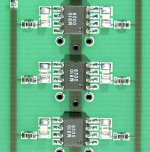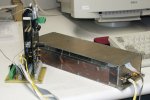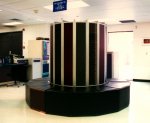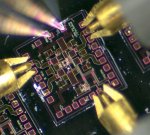Wideband Spectrometer Development in the Astronomy
Department of the University of Maryland
Wideband spectrometers are becoming increasingly important for
astronomy at millimeter and submillimeter wavelengths.
Applications include molecular line searches for primordial galaxies at
unknown redshifts and extragalactic submillimeter spectroscopy of
galaxies, whose spectral lines are very wide because of the Doppler
effect's scaling with frequency.
A review paper (pdf) from the
SOFIA/NASA Far-IR,
Sub-mm, and mm Detector Workshop provides an overview of
different wideband heterodyne spectrometers and some of their
applications to astronomy. Another paper, from the 2002 SPIE Astronomical
Telescopes and Instrumentation meeting (pdf), describes broadband analog
correlator technology and suitable receiver architectures in more
detail.
Technical information is available below on the WASP2,WASP3, APHID analog lag
correlators and their software. These are
spectrometer systems that we have been developing in the High Frequency Radio Astronomy Laboratory at the
University of Maryland.
 |
WASP2 is a 3.8 GHz bandwidth lag correlator spectrometer
optimized for heterodyne astronomical spectroscopy with moderate
resolution. This image shows three of the multipliers and the resistive
taps to the transmission lines. |
Some useful reference documents are:
- "A wideband lag correlator for
heterodyne spectroscopy of broad astronomical and atmospheric spectral
lines ," a paper describing the WASP2 instrument.
Copyright (2001) American Institute of Physics. This article may be
downloaded for personal use only. Any other use requires
prior permission of the author and the American Institute of
Physics. The article appeared in The Review of Scientific
Instruments and may be found here.
- "Spectroscopy with Multichannel
Correlation Radiometers," a paper describing cross-correlation
spectroscopy with WASP spectrometers.
- Images of the insides of the
WASP spectrometers.
- Spectrometer and component properties.
- Technical details and interfaces for the WASP2 spectrometers (pdf).
- Photograph of WASP2 on the CSO with the SURFER front-end (jpg). The large wasp in the image
is not real.
- Passband shapes for the WASP2 spectrometer with internal signal
processing for a nominal 4 to 8 GHz input with 0 dB and 3 dB internal attenuation (eps).
- Signal processing mathematics for analog autocorrelation
spectrometers (pdf, postscript).
- Assembly steps for the microwave modules (pdf, msword).
- Peter Teuben's amusing
description of our observing run at the CSO in April 2000 with many
links to many nice pictures.
A number of memos and images summarize measurements of the chips and
associated components:
 |
In its current incarnation, APHID uses a single WASP2 board
as an auto- or cross-correlator to test ideas for atmospheric phase
correction for the BIMA and OVRO millimeter wave interferometers. |
Some references:
- A memo that discusses precision
total power radiometry. It includes an exploration of the spectral
effects of nonlinearities in a correlation spectrometer (pdf; postscript).
- A document describing APHID's electrical and mechanical interfaces (pdf).
- Mechanical drawing of the APHID
module (png).
 |
Software is key to spectrometer operation. |
A preliminary set of references for the spectrometer control, data
reduction pipeline, and archiving software:
- Microcontroller commands for firmware version wasp223 (ps). Previous versions: wasp222 in ps; wasp220 in pdf, ps;
wasp219 in pdf, ps.
- Notes on frequency calculations for connecting WASP and CSO
systems (pdf, mcad). Also definitions of
various common velocity scales and FITS spectral coordinate systems (gzipped ps) (see
also Thompson, Moran & Swenson Appendix 10.2) and how to add
relativistic velocities (html).
- A set of data flow diagrams
for WASP spectrometer data processing (pdf, 65 kB; also ppt).
- Kevin Rauch and Amar's slides
describing the WASP spectrometer data processing software (postscript).
- The dictionary
of FITS keywords for the latest generation of WASP spectrometer data
acquisition and storage pipeline. This page also contains links to
references defining the FITS standard and related topics.
- Peter Teuben's spectrometer
software reference page.
- Doxygen
source code documentation for the latest generation of WASP
spectrometer data acquisition and storage pipeline.
Questions or comments? Please contact Andrew Harris.



